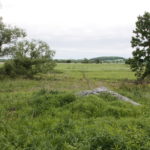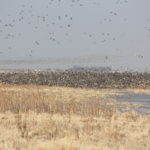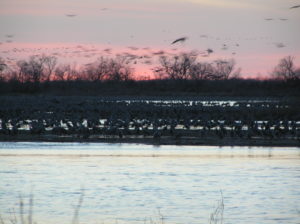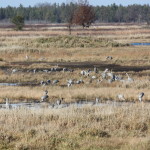
Aztalan: The View from Outside the Wall
A fortified city stood on the west bank of the Crawfish River nine centuries ago. Adobe-like walls – upright wood posts, plastered with clay – surrounded tiered platform mounds, a community plaza, and the dwellings of some four hundred people. The homes, like the fortifications, were built with what the river provided: woven willow branches sealed and bound together by the Crawfish River’s clay. Hardened clay also covered at least one of the great mound structures.
When the sun shone brightly, as it did when I visited the Crawfish River yesterday, how the city must have gleamed! Continue reading →
 The land along Prairie Lane near the Crawfish River was a cornfield for as long as I could remember. In March, 1999, I joined a volunteer work crew to help begin the process of restoring wetland and prairie habitat at Faville Grove Sanctuary. It was my first experience with habitat restoration and it changed the course of my life. This article in Wisconsin Natural Resources Magazine explains a little bit about why Faville Grove is important to me: “Rooted in the Past, a Sanctuary Grows.”
The land along Prairie Lane near the Crawfish River was a cornfield for as long as I could remember. In March, 1999, I joined a volunteer work crew to help begin the process of restoring wetland and prairie habitat at Faville Grove Sanctuary. It was my first experience with habitat restoration and it changed the course of my life. This article in Wisconsin Natural Resources Magazine explains a little bit about why Faville Grove is important to me: “Rooted in the Past, a Sanctuary Grows.”
 The land along Prairie Lane near the Crawfish River was a cornfield for as long as I could remember. In March, 1999, I joined a volunteer work crew to help begin the process of restoring wetland and prairie habitat at Faville Grove Sanctuary. It was my first experience with habitat restoration and it changed the course of my life. This article in Wisconsin Natural Resources Magazine explains a little bit about why Faville Grove is important to me: “Rooted in the Past, a Sanctuary Grows.”
The land along Prairie Lane near the Crawfish River was a cornfield for as long as I could remember. In March, 1999, I joined a volunteer work crew to help begin the process of restoring wetland and prairie habitat at Faville Grove Sanctuary. It was my first experience with habitat restoration and it changed the course of my life. This article in Wisconsin Natural Resources Magazine explains a little bit about why Faville Grove is important to me: “Rooted in the Past, a Sanctuary Grows.”





